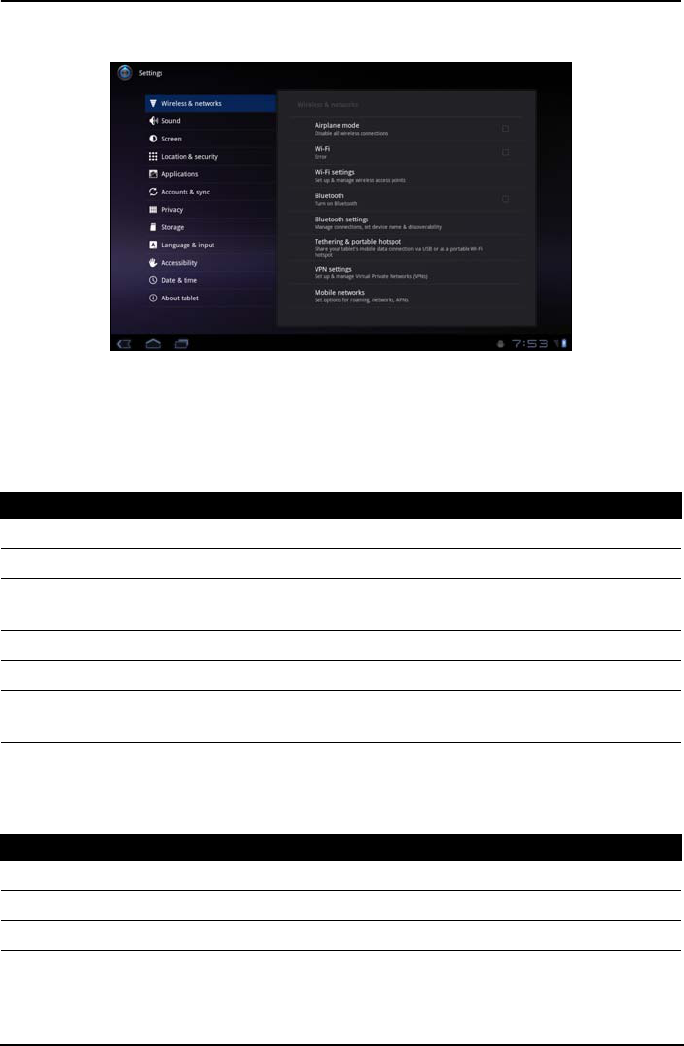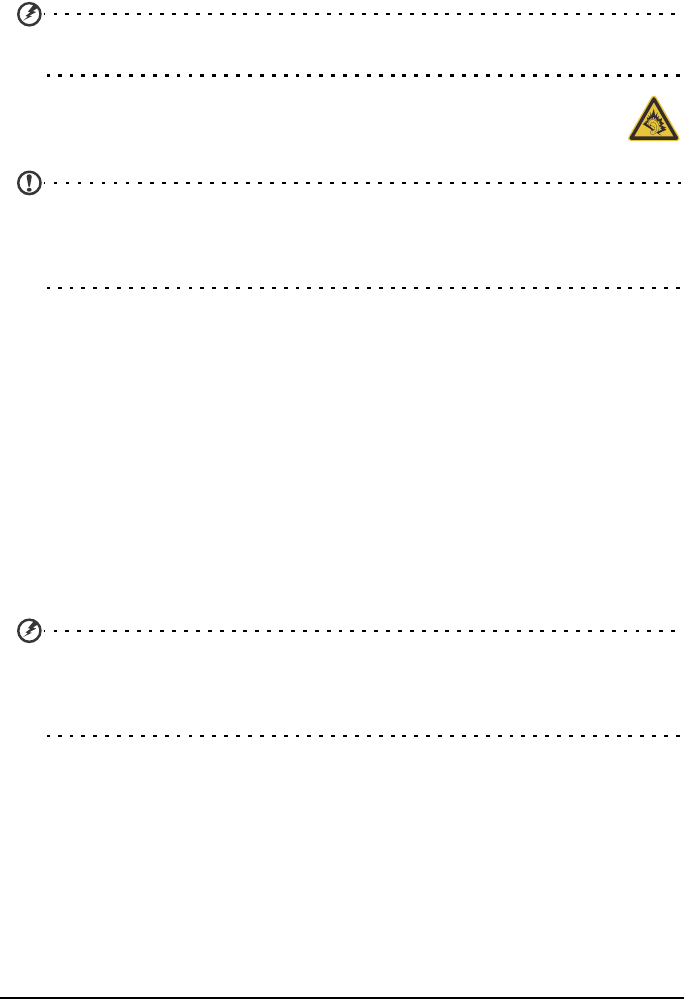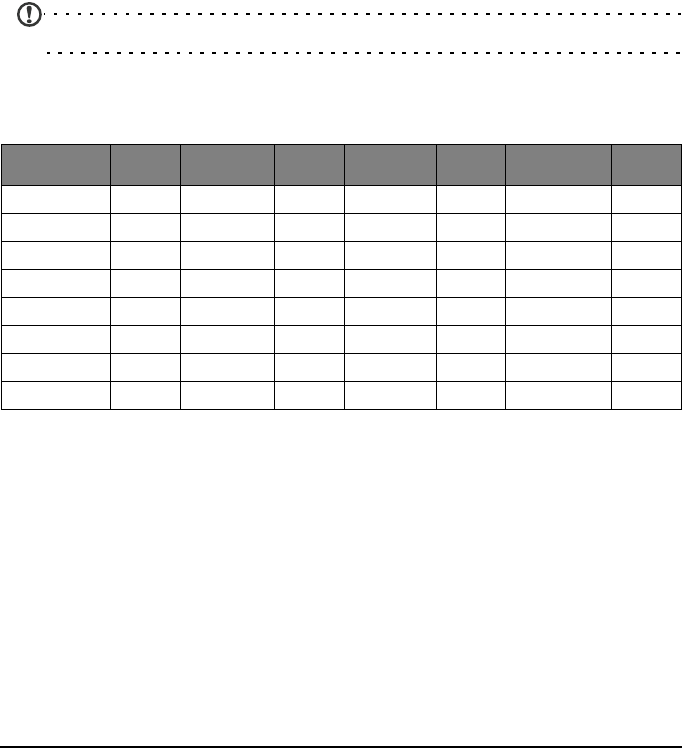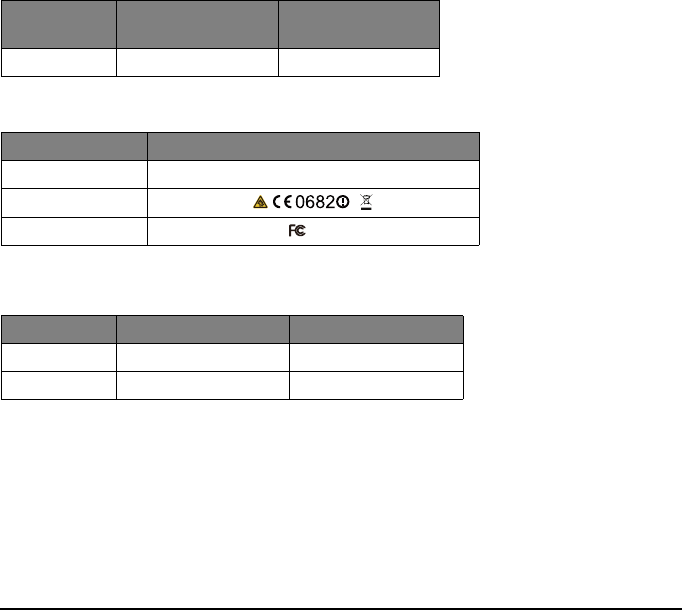Acer orporated TMDMA501A Tablet Computer User Manual Acer Picasso UM EN
Acer Incorporated Tablet Computer Acer Picasso UM EN
Contents
- 1. Manual 1
- 2. Manual 2
- 3. Manual 3
- 4. Manual 4
Manual 3

55Internet sharing
Wi-Fi hotspot
You can turn your tablet into a portable Wi-Fi hotspot to share your mobile
Internet connection with up to eight clients.
1. Tap Apps > Settings > Wireless & networks > Tethering & portable hotspot.
2. Tap Portable Wi-fi hotspot and Portable Wi-Fi hotspot settings.
3. Tap Configure Wi-Fi hotspot to set the Network SSID and adjust security
settings (such as adding a password).
4. Tap Save to finish.

56
Advanced settings
Access Settings from the Application menu. Tap Apps, then Settings.
Sound
Adjust the volume of your tablet using the volume buttons on the side of the
tablet. Alternatively, you can adjust your tablet sound settings by tapping Apps
> Settings > Sound.
Screen
You can adjust your tablet screen settings by tapping Apps > Settings > Screen.
Item Description
Vibrate Sets vibration options.
Volume Sets volume for Media, Alarm, and Notifications.
Notification
ringtone
Sets a ringtone for notifications.
Audible selection Plays a sound whenever a screen selection is made.
Screen lock sounds Plays a sound when locking and unlocking the screen.
Haptic feedback Vibrates when pressing soft keys and on certain UI
interactions.
Item Description
Brightness Adjust screen brightness.
Animation Enable window animations.
Timeout Set a delay before the screen will be turned off.

57Putting your tablet in Airplane mode
Putting your tablet in Airplane mode
You can enter Airplane mode (also known as flight mode) to turn off network
and Bluetooth functions and use your tablet during a flight. Check with your
airline to make sure this is permitted onboard.
Switch your tablet off during takeoff and landing as it may interfere with
aircraft electronic systems.
Note: When Airplane mode is active, the
icon is displayed in the status
area.
Turn Airplane mode on or off by tapping Settings > Wireless & Networks >
Airplane mode.
Activating or deactivating connections
Open the Application menu and tap Apps > Settings > Wireless & networks to
manage your connection settings.
Each connection will have a green check when turned on.
Alternatively, you can tap on the right side of the status bar to manage
connection settings.
Adjusting connection settings
This section will show you how to adjust detailed settings for your data, Wi-Fi
and Bluetooth connections.
If your tablet includes 3G features, some additional options are available:
Item Description
Airplane mode Disables all wireless connections so you can safely use this
device onboard an aircraft.
Wi-Fi Turns the Wi-Fi function on or off.
Wi-Fi settings Sets up and manages your wireless access points.
Bluetooth Turns the Bluetooth function on or off.
Bluetooth settings Manages your Bluetooth connections, sets a device name
and discoverability.
VPN settings Sets up and manages Virtual Private Networks.
Item Description
Tethering &
portable hotspot
Shares your tablet’s mobile data connection via USB or as a
portable Wi-Fi hotspot.
Mobile networks Sets your options for connecting to mobile networks.
Internet sharing Shares your mobile data connection with the connected
computer.

58
Adjusting Bluetooth settings
You can use Bluetooth to exchange information between your tablet and other
mobile devices.
Bluetooth connections
For all Bluetooth settings, tap Apps > Settings > Wireless & networks >
Bluetooth settings. Here you can switch Bluetooth on or off, set a device name
and discoverability. Tap Find nearby devices to scan for available devices.
To connect to a device, tap the device in the list of available devices. You may
be asked to enter a PIN on both devices to establish the connection.
Note: Only A2DP stereo headsets (without microphone) are supported.
Please check for updates to the tablet's software which may add support for
additional Bluetooth devices.
Connecting to a PC
If you wish to transfer information between your tablet and your computer,
you can connect your tablet to a PC using the supplied USB cable. Plug the USB
sync cable into the micro USB connector on your tablet. Plug the USB client
connector into an available USB port on your computer.
Note: You may need to install drivers on your computer before your tablet
can be used with your computer.
You will now be able to see your tablet’s internal memory as a drive in your
computer’s file explorer.
Synchronization
You can configure synchronization options for many applications on your
tablet. You can also configure what types of data you synchronize for each
account.
Some applications, such as Contacts, Gmail, and Calendar, can sync data from
multiple accounts. Others sync data only from the first Google Account you sign
into on your tablet, or from an account associated specifically with that
application.
For some applications, such as Contacts or Calendar, all changes that you make
on your tablet are made to the synchronised copy on the Internet. Other
applications only copy information from account on the Internet; the
information on your tablet cannot be changed directly, you must change the
information stored in the Internet account.
Tap Apps > Settings > Accounts & sync to access the synchronization settings.
To manage synchronization of individual accounts, tap an account name.

59Setting the date and time
Some applications, such as Gmail and Calendar, have their own
synchronization settings. Open the application and tap the
Menu
button (four bars) and then tap Accounts.
Auto-sync
To have your tablet auto-sync, make sure Background data and Auto-sync are
enabled.
•If
Background data
is enabled, applications can transmit and receive
data when you are not using them.
•If
Auto-sync
is enabled, all changes are automatically transferred
between your tablet and Internet accounts.
Acer Sync
Acer Sync allows you to easily synchronize your contacts, calendar, photos and
videos between your tablet, PC and corresponding Google services. You must
install the Acer Sync program on your computer; download and install Acer
Sync and Acer PIM for the PC from the mobile.acer.com website.
Multiple Google accounts
If you have multiple Google accounts, such as separate accounts for personal
and business contacts, you can access and synchonize them from the Accounts
settings section. Tap Apps > Settings > Accounts & sync. Tap Add account in the
top-right corner and select Google.
Setting the date and time
To set the date and time, tap Apps > Settings > Date & time.
Tip: If you travel frequently or live in an area that uses daylight saving time,
and have mobile network access, activate Automatic date & time from this
menu. Your tablet will set the date and time based on information it
receives from the network.
Setting alarms
There are two predefined alarms on your tablet by default. To add or edit
alarm settings, tap Clock in the application menu and tap Set alarm.
Tap Add alarm to create a new alarm, or tap the check box next to a preset
alarm to turn it on or off.
Tap a preset alarm to edit it. You can:
• Turn the alarm on or off.
• Set the alarm time.
• Set which days to repeat the alarm.
• Set a ringtone.
• Enable or disable vibrate.
• Give it a label (i.e. a name).

60
Changing language and text options
Set your location and language input preferences by opening the application
menu and going to Apps > Settings > Language & input.
Managing applications
You can allow programs from Unknown sources to be installed and Manage
applications.
Closing an application
To close an active application, go to Settings > Applications > Manage
applications. Tap the Running tab, then tap the program you wish to close.
Select Force stop to close the program.
Uninstalling an application
You can remove programs installed on your tablet to free up extra storage
memory. Tap and hold a program icon from the application menu and drag it
into the Uninstall area in the top-right corner.
Note: You cannot uninstall applications that were pre-loaded on your
tablet.
Alternatively, you can go to Apps > Settings and select Applications > Manage
applications. Tap the application you wish to uninstall, tap Uninstall and
confirm the uninstall.
Warning! You should only remove programs if you are familiar with the
Android operating system.
Updating your tablet’s operating system
Your tablet can download and install system updates, adding support for new
devices or expanding software options.
To check for updates, tap Apps > Settings > About tablet > System update >
Check now.
Note: Downloading new firmware can take up to 40 minutes, depending on
your network speed.
Resetting your tablet
You may have to perform a reset if your tablet fails to respond when buttons
are pressed or the screen is tapped.
To reset your tablet use a small thin object (such as a paperclip) to press the
recessed reset button. See “Bottom view” on page 11.

61Resetting your tablet
Clean boot
A clean boot will restore your tablet to the factory settings.
Warning! This will erase all your personal information, any contacts stored
on your tablet and any programs you installed.
Open Settings from the application menu, then tap Privacy > Factory data reset;
click Reset tablet and then Erase everything to format your tablet.
If your tablet still does not respond, refer to “FAQ and troubleshooting” on
page 62.

62
FAQ and troubleshooting
This section lists frequently asked questions that may arise during the use of
your tablet, and gives easy answers and solutions to these questions.
Aspect Question Answer
Audio Why is there no
sound coming from
the device?
If the headset is plugged into the
device, the speaker is automatically
shut off. Disconnect the headset.
Check that the device volume setting is
not muted.
Check that the volume control is not at
its lowest setting.
Multimedia files Why can’t I view my
picture files?
You may be trying to view an image
that is not supported. Refer to
“Multimedia” on page 64 for more
information.
Why can’t I view my
video files?
You may be trying to view a video that
is not supported. Refer to
“Multimedia” on page 64 for more
information.
Why can’t I play my
music files?
You may be trying to play a file that is
not supported. Refer to “Multimedia”
on page 64 for more information.
System
information and
performance
How do I check the
OS version of my
device?
Tap Apps > Settings > About tablet to
check the OS version (Kernel/build
number) and other hardware and
software information.
Power I couldn’t turn on
the device.
The battery power may be depleted.
Recharge the device. Refer to
“Charging your tablet” on page 12 for
more information.
Storage How do I check
memory status?
To check storage status, go to Settings
> Storage.

63Other sources of help
Other sources of help
Unlock pattern I forgot my unlock
pattern.
After a certain number of wrong
entries, you will be presented with an
option to reset your pattern. Tap
Forgot pattern? and enter your google
account username and password.
Note: You must have an active
Google account on the tablet.
Alternatively, you can clean boot the
tablet and erase all data. See “Clean
boot“ on page 61.
Heat The tablet heats up
when charging or
operating for a long
period.
It is normal for the device to heat up
when charging. When charging is
complete, it will return to its normal
temperature.
It is also normal for the tablet to heat
up during long periods of use, such as
watching a video or playing a game.
All Acer tablets are factory tested
before release.
For information on: Refer to:
Up-to-date information regarding
your tablet
www.acer.com
Service enquiries support.acer.com
Aspect Question Answer

64
Specifications
Performance
•NVIDIA
® Tegra™ 2 mobile processor
• Dual Core ARM® Cortex™-A9
• System memory:
•1 GB of RAM
•16 or 32 GB of flash memory
• Google Android™ operating system
Display
• 10.1” WXGA TFT-LCD capacitive multi-touch screen
• 1280 x 800 resolution
• 262K colors support
Multimedia
• Micro (Type D) HDMI output
• CD-quality stereo output
• Stereo speakers
• Dual microphone with noise and echo cancellation
• Dolby Mobile
Formats supported:
USB connectors
• USB connector (host)
• Micro USB connector (slave)
Power
• DC power-in (12 V, 1.5 A)
Connectivity
• Bluetooth 2.1+EDR & A2DP support
• Wi-Fi 802.11b/g/n WLAN (802.11n -> 2.4GHz only)
•GPS
Type Formats
Audio recording AAC-LC, AMR-WB
Audio playback AAC-LC, AAC, AAC+ (Not raw AAC), AMR-NB, AMR-WB, MP3,
OGG Vorbis, WAV
Video recording H.264 BP, MPEG-4 SP, H.263
Video playback H.264 BP, H.264 MP, H.264 HP, MPEG-4 SP, H.263

65
3G support (only available on Wi-Fi+3G models)
•aGPS
• GSM 850 / 900 / 1800 / 1900
• UMTS 850 / 900 / 1900 / 2100
• HSDPA 7.2 Mbps / HSUPA 5.76 Mbps / EDGE / GPRS
• Optional HSDPA 21 Mbps
Camera
• Front camera
• 2-megapixel
•F
ixed focus
• Rear camera
• 5-megapixel
•F
lash
•Auto focus
Expansion
• microSD memory card slot (up to 32 GB)
Battery
• Rechargeable high density Li-polymer batteries: 3260 mAh x 2 (24.1 Wh)
Note: Length of battery operation will depend on power consumption
which is based on system resource use. For example, constantly using the
backlight or using power-demanding applications will shorten battery life
between charges.
Dimensions
Height 260 mm
Width 177 mm
Thickness 13.3 mm
Weight (Wi-Fi only model) 765 g
Weight (Wi-Fi+3G model) 777 g

66
Safety
Prevention of hearing loss
Caution: Permanent hearing loss may occur if earphones or headphones are
used at high volume for prolonged periods of time.
This device have been tested to comply with the Sound Pressure Level
requirement laid down in the applicable EN 50332-1 and/or EN 50332-2
standards.
Note: For France, mobile headphones or earphones for this device have
been tested to comply with the Sound Pressure requirement laid down in
the applicable NF EN 50332-1:2000 and/or NF EN 50332-2:2003 standards as
required by French Article L. 5232-1.
A pleine puissance, l’écoute prolongée du baladeur peut endommager l’oreille
de l’utilisateur.
CAUTION when listening
To protect your hearing, follow these instructions.
• Increase the volume gradually until you can hear clearly and
comfortably.
• Do not increase the volume level after your ears have adjusted.
• Do not listen to music at high volumes for extended periods.
• Do not increase the volume to block out noisy surroundings.
• Decrease the volume if you can’t hear people speaking near you.
Radio Frequency Interference
Warning! For safety reasons, turn off all wireless or radio transmitting
devices when using your device under the following conditions. These
devices may include, but are not limited to: wireless LAN (WLAN), Bluetooth
and/or 3G.
Remember to follow any special regulations in force in any area, and always
switch off your device when its use is prohibited or when it may cause
interference or danger. Use the device only in its normal operating positions. To
successfully transmit data files or messages, this device requires a good quality
connection to the network. In some cases, transmission of data files or messages
may be delayed until such a connection is available. Ensure that the above
separation distance instructions are followed until the transmission is
completed. Parts of the device are magnetic. Metallic materials may be
attracted to the device, and persons with hearing aids should not hold the
device to the ear with the hearing aid. Do not place credit cards or other

67Safety
magnetic storage media near the device, because information stored on them
may be erased.
Medical devices
Operation of any radio transmitting equipment, including wireless phones, may
interfere with the functionality of inadequately protected medical devices.
Consult a physician or the manufacturer of the medical device to determine if
they are adequately shielded from external RF energy or if you have any
questions. Switch off your device in health care facilities when any regulations
posted in these areas instruct you to do so. Hospitals or health care facilities
may be using equipment that could be sensitive to external RF transmissions.
Pacemakers. Pacemaker manufacturers recommend that a minimum separation
of 15.3 cm (6") be maintained between wireless devices and a pacemaker to
avoid potential interference with the pacemaker. These recommendations are
consistent with the independent research by and recommendations of Wireless
Technology Research. Persons with pacemakers should do the following:
• Always keep the device more than 15.3 cm (6") from the pacemaker.
• Not carry the device near your pacemaker when the device is switched
on. If you suspect interference, switch off your device, and move it.
Hearing aids. Some digital wireless devices may interfere with some hearing
aids. If interference occurs, consult your service provider.
Vehicles
RF signals may affect improperly installed or inadequately shielded electronic
systems in motor vehicles such as electronic fuel injection systems, electronic
antiskid (antilock) braking systems, electronic speed control systems, and air
bag systems. For more information, check with the manufacturer, or its
representative, of your vehicle or any equipment that has been added. Only
qualified personnel should service the device, or install the device in a vehicle.
Faulty installation or service may be dangerous and may invalidate any
warranty that may apply to the device. Check regularly that all wireless
equipment in your vehicle is mounted and operating properly. Do not store or
carry flammable liquids, gases, or explosive materials in the same compartment
as the device, its parts, or enhancements. For vehicles equipped with an air bag,
remember that air bags inflate with great force. Do not place objects, including
installed or portable wireless equipment in the area over the air bag or in the
air bag deployment area. If in-vehicle wireless equipment is improperly
installed, and the air bag inflates, serious injury could result. Using your device
while flying in aircraft is prohibited. Switch off your device before boarding an
aircraft. The use of wireless teledevices in an aircraft may be dangerous to the
operation of the aircraft, disrupt the wireless telephone network, and may be
illegal.
Potentially explosive environments
Switch off your device when in any area with a potentially explosive
atmosphere and obey all signs and instructions. Potentially explosive
atmospheres include areas where you would normally be advised to turn off

68
your vehicle engine. Sparks in such areas could cause an explosion or fire
resulting in bodily injury or even death. Switch off the device at refueling
points such as near gas pumps at service stations. Observe restrictions on the
use of radio equipment in fuel depots, storage, and distribution areas; chemical
plants; or where blasting operations are in progress. Areas with a potentially
explosive atmospheres are often, but not always, clearly marked. They include
below deck on boats, chemical transfer or storage facilities, vehicles using
liquefied petroleum gas (such as propane or butane), and areas where the air
contains chemicals or particles such as grain, dust or metal powders.
Follow any restrictions. Do not use the device where blasting is in progress.
Emergency calls
(only for models supporting phone function)
Important: Wireless products, including this device, operate using radio
signals, wireless networks, landline networks, and user-programmed
functions. Because of this, connections in all conditions cannot be
guaranteed. You should never rely solely on any wireless device for essential
communications like medical emergencies.
If certain features are in use, you may first need to turn those features off
before you can make an emergency call. Consult this guide or your service
provider for more information.
When making an emergency call, give all the necessary information as
accurately as possible. Your wireless device may be the only means of
communication at the scene of an accident. Do not end the call until given
permission to do so.
Operation environment
Make sure that the device:
• Is away from magnetic fields or any device generating static electricity.
• Is kept at least 30 centimetres (one foot) away from a mobile phone.
• Is not in a dusty or damp environment.
• Is not used near water. Never spill liquids of any kind on or into your
device.
• Cables are not strained and that there is no risk of people walking or
tripping over them.
• Other devices do not crush the cables.
• Always unplug your device from the power outlet before cleaning it.
• Do not use liquid or aerosol cleaners, use a damp cloth instead.
• Never spray cleaning product directly on the screen.
• If you spill liquid on your device, switch it off immediately, unplug the
AC adapter. Do not attempt to service your device yourself, as opening
or removing covers may expose you to dangerous voltage or other risks.
Refer all servicing to qualified service personnel.

69Safety
Unplug your device from the wall outlet and refer servicing to qualified service
personnel when:
• the power cord or plug is damaged, cut or frayed,
• liquid was spilled into the product,
• the product was exposed to rain or water,
• the product has been dropped or the case has been damaged
• the product exhibits a distinct change in performance, indicating a need
for service
Note: Adjust only those controls that are covered by the operating
instructions, since improper adjustment of other controls may result in
damage and will often require extensive work by a qualified technician to
restore the product to normal condition.
Battery information
This product uses a Lithium-ion / Li-polymer battery. Do not use it in a humid,
wet and/or corrosive environment. Do not put, store or leave your product in or
near a heat source, in a high temperature location, in strong direct sunlight, in
a microwave oven or in a pressurized container, and do not expose it to
temperatures over 60 °C (140 °F). Failure to follow these guidelines may cause
the battery to leak acid, become hot, explode or ignite and cause injury and/or
damage. Do not pierce, open or disassemble the battery. If the battery leaks
and you come into contact with the leaked fluids, rinse thoroughly with water
and seek medical attention immediately. For safety reasons, and to prolong the
lifetime of the battery, charging will not occur at low (below 0 °C/32 °F) or high
(over 40 °C/104 °F) temperatures.
The full performance of a new battery is achieved only after two or three
complete charge and discharge cycles. The battery can be charged and
discharged many times, but it will eventually wear out. When normal use and
standby times are noticeably shorter than normal, contact your reseller. Use
only Acer approved batteries, and recharge your battery only with Acer
approved chargers designated for this device.
Unplug the charger from the electrical plug and the device when not in use. If
left unused, a fully charged battery will lose its charge over time. If the battery
is completely discharged, it may take a few minutes before the charging
indicator appears on the display or before the device can be used.
Use the battery only for its intended purpose. Never use any charger or battery
that is damaged.
Do not short-circuit the batteries under any condition. Accidental short-
circuiting can occur when a metallic object such as a coin, clip, or pen causes
direct connection of the positive (+) and negative (-) terminals of the battery.
(These look like metal strips on the battery.) This might happen, for example,
when you carry a spare battery in your pocket or purse. Short-circuiting the
terminals may damage the battery or the connecting object.

70
Leaving the battery or any device with embedded batteries in hot or cold
places, such as in a closed car in summer or winter conditions, will reduce the
capacity and lifetime of the battery. Always try to keep the battery between 15
°C and 25 °C (59 °F and 77 °F). A device with a hot or cold battery may not work
temporarily, even when the battery is fully charged. Battery performance is
particularly limited in temperatures well below freezing.
Do not dispose of battery or devices with embedded batteries in a fire as they
may explode. Batteries may also explode if damaged. Dispose of batteries
according to local regulations. Please recycle when possible. Do not dispose as
household waste.
• Avoid leaving this device or battery in your car in high temperatures.
• Avoid dropping this device or battery. It can cause damage.
• Contact your service provider or reseller to have them checked if this
device or battery get wet or damaged from dropping or high
temperature.
Replace battery: Use original products for quality assurance and safeguards.
Battery cannot be removed and replaced, contact your reseller if performance
of battery shall be checked.
Warning: Use of a non-original battery or charger may present a risk of fire,
explosion, leakage, or other hazard.
Warning! Batteries may explode if not handled properly. Do not
disassemble or dispose of them in fire. Keep them away from children.
Follow local regulations when disposing of used batteries.
IEEE1625 statement
A. Do not disassemble or open, crush, bend or deform, puncture, or shred.
B. Do not modify or remanufacture, attempt to insert foreign objects into the
battery, immerse or expose to water or other liquids, or expose to excessive
heat, fire, or otherhazard. Only use the battery in the system for which it was
specified.
C. Only use the battery with a charging system that has been qualified with the
system per this standard.
D. Use of an unqualified battery or charger may present a risk of fire, explosion,
leakage,or other hazard.
E. Do not short-circuit a battery or allow metallic or conductive objects to
contact the battery terminals.
F. Replace the battery only with another battery that has been qualified with
the system per this standard.
G. Use of an unqualified battery may present a risk of fire, explosion, leakage,
or other hazard.
H. Promptly dispose of used batteries in accordance with local regulations.
I. Battery usage by children should be supervised.

71Safety
J. Avoid dropping the host or battery. If the host or battery is dropped,
especially on a hard surface, and the end user suspects damage, take it to a
service center for inspection.
K. Improper battery use may result in a fire, explosion, leakage, or other
hazard.
L. Storage and operating conditions, including temperature, shall be specified.
Driving safety
Using this device while driving may cause distraction. Stop using it if you can’t
concentrate on driving. Input information about your destination and route
prior to your drive. Do not input data or engage in text messaging while
driving. Keep your eyes on the road while driving. Listen to the audible turn-by-
turn directions, if available. Also, using a mobile device or accessory may be
prohibited or restricted in certain areas. Always obey the laws and regulations
on the use of these products.
GPS & AGPS (for certain models only)
• Your device may use Global Positioning System (GPS) signals for
location-based applications. GPS uses satellites controlled by the U.S.
government that are subject to changes implemented in accordance
with the Department of Defense policy and the Federal Radio
Navigation Plan. These changes may affect the performance of location
technology on your device.
• Your device may also use Assisted Global Positioning System (AGPS),
which obtains information from a cellular network to improve GPS
performance. AGPS uses your wireless service provider’s network and
therefore airtime, data charges, and/or additional charges may apply in
accordance with your service plan. Contact your wireless service provider
for details.
• Device enabled with GPS or AGPS technology transmit location-based
information. This location-based information may be shared with third
parties, including your wireless service provider, application providers,
and other third parties providing service.
Emergency calls
• When you make an emergency call, the cellular network may activate
the AGPS technology in your mobile device to tell the emergency
responders your approximate location.
• AGPS has limitations and might not work in your area. Therefore:
• Always tell the emergency responder your location to the best of your ability, and
• Remain on the device for as long as the emergency responder instructs you.
• Get better performance by going outside and away from underground
locations, covered vehicles, structures with metal or concrete roots, tall
buildings, and foliage.
• Indoor performance might improve if move closer to windows, but some
windows sun shielding films can block satellite signals.
• Get better performance by moving away from radios, entertainment
equipment, and other electronic devices.

72
Keep away from children
• Keep your device & its accessories away from small children, a chocking
hazard may exist for small, detachable parts.
• Improper use may cause load sounds, possibly causing hearing injury.
• Improperly handled this device or batteries could overheat and cause a
burn.
Glass parts
Some of parts of your device may be made of glass. This glass could break if the
product is dropped on a hard surface or receives a substantial impact. If glass
breaks, do not touch or attempt to remove. Stop using your device until the
glass is replaced by a qualified service center.
Seizures/Blackouts/Eyestrain
A small percentage of people may be susceptible to blackouts or seizures (even
if they have never had one before) when exposed to flashing lights or light
patterns such as when playing games or watching video. If you have
experienced seizures or blackouts or have a family history of such occurrences,
you should consult a physician before playing games or watching videos on
your device. Discontinue use and consult a physician if any of the following
symptoms occur: convulsion, eye or muscle twitching, loss of awareness,
involuntary movements, or disorientation. It is always a good idea to hold the
screen away from your eyes, leave the light on in the room, take a not-less-
than-15-minute break every hour, and stop use it if you are tired.
Repetitive motion
When you repetitively perform actions such as pressing keys or entering finger-
written characters, you may experience occasional discomfort in your hands,
arms, shoulders, neck, or other parts of your body. If you continue to have
discomfort during or after such use, stop use and see a physician.
Use of connectors and ports
Never force a connector into a port. Check for obstructions on the port. If the
connector and port don’t join with reasonable ease, they probably don’t match.
Make sure that the connector matches the port and that you have positioned
the connector correctly in relation to the port.
Information from World Health Organization
Present scientific information does not indicate the need for any special
precautions for the use of mobile device. If you are concerned, you may want to
limit your own or your children’s RF exposure by limiting the length of calls or
by using handsfree devices to keep mobile devices away from your head and
body.
Source: WHO Fact Sheet 193
Further information: http://www.who.int/peh-emf
Consumer information on wireless device
The U.S. Food and Drug Administration (FDA) has published a series of
Questions and Answer for consumers relating to radio frequency (RF) exposure

73Safety
from wireless phone devices: http://www.fda.gov/Radiation-EmittingProducts/
RadiationEmittingProductsandProcedures/HomeBusinessandEntertainment/
CellPhones/default.htm
Additional information on the safety of RF exposures:
FCC RF Safety program: http://www.fcc.gov/oet/rfsafety
Environmental Protection Agency (EPA): http://www.epa.gov/radiation
International Commission on Non-Ionizing Radiation Protection:
http://www.icnirp.de
Export Law Assurances
This product, including any software or technical data contained in or
accompanying the product, may be subject to import and export regulations of
the European Union, the United States of America, Canada and other countries/
regions. The Government of those countries/regions may restrict the
exportation or re-exportation of this product to certain destinations. For
further information refer to European Council Regulation (EC) 1334/2000,
contact the U.S. Department of Commerce or the Canadian Department of
Foreign Affairs and International Trade, and other local government
authorities.
Protection of personal information
Erase personal data before disposing of the product. To delete data, perform a
master reset. Deleting date from the device memory does not ensure that it
cannot be recovered.
Disposal and recycling information
Do not throw this electronic device into the trash when discarding.
To minimize pollution and ensure utmost protection of the global
environment, please recycle. For more information on the Waste from
Electrical and Electronics Equipment (WEEE) regulations, visit www.acer-
group.com/public/Sustainability/sustainability01.htm
RoHS compliance
This product is in compliance with Directive 2002/95/EC of the European
Parliament and of the Council of 27 January 2003, on the restriction of the use
of certain hazardous substances in electrical and electronic equipment (RoHS)
and its amendments.
Disposal of your device packaging & product guide should be in accordance
with national collection and recycling requirements. Contact your regional
authorities for more details.
LCD pixel statement
The LCD unit is produced with high-precision manufacturing techniques.
Nevertheless, some pixels may occasionally misfire or appear as black or red
dots. This has no effect on the recorded image and does not constitute a
malfunction.

74
Radio device regulatory notice
Note: Regulatory information below is for models with wireless LAN and/or
Bluetooth only.
General
This product complies with the radio frequency and safety standards of any
country or region in which it has been approved for wireless use. Depending on
configuration, this product may or may not contain wireless radio devices (such
as wireless LAN and/or Bluetooth modules). Information below is for products
with such devices.
Wireless operation channels for different domains
This equipment is in compliance with the essential requirements and other
relevant provisions of Directive 1999/5/EC.
France: Restricted wireless frequency bands
Some areas of France have a restricted frequency band. The worst case
maximum authorized power indoors is:
• 10 mW for the entire 2.4 GHz band (2400 MHz - 2483.5 MHz)
• 100 mW for frequencies between 2446.5 MHz and 2483.5 MHz
Note: Channels 10 through 13 inclusive operate in the band 2446.6 MHz to
2483.5 MHz.
There are few possibilities for outdoor use: On private property or on the
private property of public persons, use is subject to a preliminary authorization
procedure by the Ministry of Defense, with maximum authorized power of 100
mW in the 2446.5 - 2483.5 MHz band. Use outdoors on public property is not
permitted.
In the departments listed below, for the entire 2.4 GHz band:
• Maximum authorized power indoors is 100 mW
• Maximum authorized power outdoors is 10 mW
N. America 2.412-2.462 GHz Ch01 through Ch11
Japan 2.412-2.484 GHz Ch01 through Ch14
Europe ETSI 2.412-2.472 GHz Ch01 through Ch13

75Safety
Departments in which the use of the 2400 - 2483.5 MHz band is permitted with
an EIRP of less than 100 mW indoors and less than 10 mW outdoors:
This requirement is likely to change over time, allowing you to use your wireless
LAN card in more areas within France. Please check with ART for the latest
information (www.art-telecom.fr).
Note: Your WLAN Card transmitts less than 100 mW, but more than 10 mW.
List of National Codes
This equipment may be operated in the following countries:
FCC regulations
This mobile device complies with part 15 of the FCC Rules. Operation is subject
to the following two conditions: (1) This device may not cause harmful
interference, and (2) this device must accept any interference received,
including interference that may cause undesired operation.
This mobile device has been tested and found to comply with the limits for a
Class B digital device, pursuant to Part 15 of the FCC Rules. These limits are
designed to provide reasonable protection against harmful interference in a
residential installation. This equipment generates, uses and can radiated radio
frequency energy and, if not installed and used in accordance with the
instructions, may cause harmful interference to radio communications.
However, there is no guarantee that interference will not occur in a particular
01 Ain Orientales
02 Aisne
03 Allier
05 Hautes Alpes
08 Ardennes
09 Ariege
11 Aude
12 Aveyron
16 Charente
24 Dordogne
25 Doubs
26 Drome
32 Gers
36 Indre
37 Indre et Loire
41 Loir et Cher
45 Loret
50 Manche
55 Meuse
58 Nievre
59 Nord
60 Oise
61 Orne
63 Puy Du Dome
64 Pyrenees Atlantique
66 Pyrenees
67 Bas Rhin
68 Haut Rhin
70 Haute Saone
71 Saone et Loire
75 Paris
82 Tarn et Garonne
84 Vaucluse
88 Vosges
89 Yonne
90 Territoire de Belfort
94 Val de Marne
Country ISO 3166 2
letter code
Country ISO 3166 2
letter code
Country ISO 3166 2
letter code
Country ISO 3166 2
letter code
Austria AT Germany DE Malta MT United Kingdom GB
Belgium BE Greece GR Netherlands NT Iceland IS
Cyprus CY Hungary HU Poland PL Liechtenstein LI
Czech Republic CZ Ireland IE Portugal PT Norway NO
Denmark DK Italy IT Slovakia SK Switzerland CH
Estonia EE Latvia LV Slovenia SL Bulgaria BG
Finland FI Lithuania LT Spain ES Romania RO
France FR Luxembourg LU Sweden SE Turkey TR

76
installation If this equipment does cause harmful interference to radio or
television reception, which can be determined by turning the equipment off
and on, the user is encouraged to try to correct the interference by one or more
of the following measures:
• Reorient or relocate the receiving antenna.
• Increase the separation between the equipment and receiver.
• Connect the equipment into an outlet on a circuit different from that to
which the receiver is connected.
• Consult the dealer or an experienced radio/TV technician for help.
Changes or modifications not expressly approved by the party responsible for
compliance could void the user's authority to operate the equipment.
RF exposure warning
The equipment complies with FCC RF exposure limits set forth for an
uncontrolled environment.
The antenna(s) used for this transmitter must not be co-located or operating in
conjunction with any other antenna or transmitter
For Canadian users
Operation is subject to the following two conditions: (1) this device may not
cause interference, and (2) this device must accept any interference, including
interference that may cause undesired operation of the device.
This Class B digital apparatus complies with Canadian ICES-003.
Cet appareil numérique de la classe B est conforme à la norme NMB-003 du
Canada.
This Category II radiocommunication device complies with Industry Canada
Standard RSS-310.
Ce dispositif de radiocommunication de catégorie II respecte la norme CNR-310
d’Industrie Canada.
Regulatory information
Compliant with Russian regulatory certification (for Russian)
NCC 警語
經型式認證合格之低功率射頻電機,非經許可,公司、商號或使用者均不得擅自變更
頻率、加大功率或變更原設計之特性及功能。
低功率射頻電機之使用不得影響飛航安全及干擾合法通信;經發現有干擾現象時,應
立即停用,並改善至無干擾時方得繼續使用。
前項合法通信,指依電信法規定作業之無線電通信。
低功率射頻電機須忍受合法通信或工業、科學及醫療用電波輻射性電機設備之干擾。
* 減少電磁波影響,請妥善使用。(* 僅限電話手機機種 )

77Safety
Lithium-ion / Li-polymer battery warning
ATTENZIONE! Rischio di esplosione della batteria se sostituita in modo errato.
Sostituire la batteria con un una di tipo uguale o equivalente consigliata
dalla fabbrica. Non disperdere le batterie nell’ambiente.
VORSICHT! Explosionsgefahr bei unsachgemäßen Austausch der Batterie.
Ersatz nur durch denselben oder einem vom Hersteller empfohlenem ähnli-
chen Typ. Entsorgung gebrauchter Batterien nach Angaben des Herstellers.
ADVARSELI! Lithiumbatteri - Eksplosionsfare ved fejlagtig håndtering.
Udskiftning må kun ske med batteri af samme fabrikat og type. Levér det
brugte batteri tilbage til leverandøren.
VARNING! Explosionsfara vid felaktigt batteribyte. Använd samma batterityp
eller en ekvivalent typ som rekommenderas av apparattillverkaren. Kassera
använt batteri enligt fabrikantens instruktion.
VAROITUS! Paristo voi räjähtää, jos se on virheellisesti asennettu. Vaihda
paristo ainoastaan laitevalmistajan sousittelemaan tyyppiin. Hävitä käytetty
paristo valmistagan ohjeiden mukaisesti.
ATTENTION ! Il y a danger d’explosion s’il y a remplacement incorrect de la
batterie. Remplacer uniquement avec une batterie du mêre type ou d’ un
type équivalent recommandé par le constructeur. Mettre au rebut les batter-
ies usagées conformément aux instructions du fabricant.
ADVARSEL! Eksplosjonsfare ved feilaktig skifte av batteri. Benytt samme bat-
teritype eller en tilsvarende type anbefalt av apparatfabrikanten. Brukte bat-
terier kasseres i henhold til fabrikantens instruksjoner.

78
RF exposure information (SAR)
This device meets the government's requirements for exposure to radio waves.
This device is designed and manufactured not to exceed the emission limits for
exposure to radio frequency (RF) energy set by the Federal Communications
Commission of the U.S. Government.
The exposure standard for wireless devices employs a unit of measurement
known as the Specific Absorption Rate, or SAR. The SAR limit set by the FCC is
1.6 W/kg.
Tests for SAR are conducted using standard operating positions accepted by the
FCC with the device transmitting at its highest certified power level in all tested
frequency bands. Although the SAR is determined at the highest certified
power level, the actual SAR level of the device while operating can be well
below the maximum value. This is because the device is designed to operate at
multiple power levels so as to use only the poser required to reach the network.
In general, the closer you are to a wireless base station antenna, the lower the
power output.
Important: Body-worn measurements differ among device models,
depending upon available enhancements and FCC requirements.
While there may be differences between the SAR levels of various devices and
at various positions, they all meet the government requirements.
The FCC has granted an Equipment Authorization for this model device with all
reported SAR levels evaluated as in compliance with the FCC RF exposure
guidelines. SAR information on this model device is on file with the FCC and can
be found under the Display Grant section of http://www.fcc.gov/oet/ea/fccid
after searching on the FCC ID described below.
For body worn operation, this device has been tested and meets the FCC RF
exposure guidelines for use with accessories that contain no metal and that
position the handset a minimum of 0 cm from the body. Use of other
accessories may not ensure compliance with FCC RF exposure guidelines. If you
do not use a body-worn accessory and are not holding the device at the ear,
position the handset a minimum of 0 cm from your body when the device is
switched on.
Certificate Information (SAR)
This device meets the EU requirements (1999/519/EC) on the limitation of
exposure of the general public to electromagnetic fields by way of health
protection.
The limits are part of extensive recommendations for the protection of the
general public. These recommendations have been developed and checked by
independent scientific organizations through regular and thorough evaluations
of scientific studies. To guarantee the safety of all persons, regardless of age
and health, the limits include a significant safety buffer.

79
Before radio devices can be put in circulation, their agreement with European
laws or limits must be confirmed; only then may the CE symbol be applied.
The unit of measurement for the European Council's recommended limit for
mobile devices is the "Specific Absorption Rate" (SAR). This SAR limit is 2.0 W/
kg, averaged over 10 g of body tissue. It meets the requirements of the
International Commission on Non-Ionizing Radiation Protection (ICNIRP). The
maximum SAR value is calculated at the highest output level in all frequency
bands of the mobile device.
For body worn operation, this device has been tested and meets the ICNIRP
exposure guidelines and was included in the European Standard EN 62311 and
EN 62209-2 for use with accessories that contain no metal and that position the
handset a minimum of 1.5 cm from the body. Use of other accessories may not
ensure compliance with ICNIRP exposure guidelines. If you do not use a body-
worn accessory and are not holding the device at the ear, position the handset
a minimum of 1.5 cm from your body when the device is switched on.
During use, the actual SAR level is usually much lower than the maximum value,
because the mobile device works in different output levels. It only transmits
with as much output as is required to reach the network. In general the
following applies: The closer you are to a base station, the lower the
transmission output of your mobile device.
Model
CE
Body
FCC
Body
A501 0.453 W/kg -
Certification marks and Compliance
Region Certification and Compliance
Canada IC
E.U. ,
U.S. FCC
You can view certification logos on your device: open Settings > About tablet >
Legal information > Certification Logo.
Model FCC ID IC ID
A500 HZLTMDMA500 1754F-TMDMA500
A501 HLZTMDMA501A 1754F-TMDMA501A
For Canadian users
Important note
IC radiation exposure statement
This EUT is compliance with SAR for general population/uncontrolled exposure
limits in IC RSS-102 and had been tested in accordance with the measurement
methods and procedures specified in IEEE 1528. This equipment should be

80
installed and operated with minimum distance 0 cm between the radiator and
your body.
This device and its antenna(s) must not be co-located or operating in
conjunction with any other antenna or transmitter.
Note: The country code selection feature is disabled for products marketed
in the US/Canada.

81
Acer Incorporated
Date: March 2, 2011
Declaration of Conformity
We, Acer Incorporated,
of 8F., No. 88, Sec. 1, Xintai 5th Rd., Xizhi Dist, New Taipei City, 22181, Taiwan
Declare under sole responsibility that the product:
Model: A500
Description: Tablet Computer
To which this declaration relates, is in conformity with the following standards
and/or other normative documents:
• EN 300 328 V1.7.1
• EN 300 440-1 V1.6.1 ; EN300 440-2 V1.4.1
• EN 301 489-1 V1.8.1 ; EN 301489-3 V1.4.1 ; EN 301489-17 V2.1.1
• EN 55022:2006/A1:2007 Class B ; EN 55024:1998/A1:2001/A2:2003
• EN 60950-1: 2006+A11:2009
• EN 50332-2: 2003
• EN62311:2008; EN62209-2:2010
We hereby declare that the above named product is in conformance to all the
essential requirements of the R&TTE Directive (99/5/EC) issued by the Commission
of the European Community.
The conformity assessment procedure referred to in Article 10 and detailed in
Annex [IV] of directive 1999/5/EC has been followed related to Articles:
• R&TTE Article 3.1 (a) Health and Safety
• R&TTE Article 3.1 (b) EMC
• R&TTE Article 3.2 Spectrum Usage
with the involvement of the following Notified Body:
CETECOM, Untertuerkheimer Str. 6 – 10 66117 Saarbruecken
Identification mark: 0682 (Notified Body) CE
The technical documentation relevant to the above equipment will be held at:
Acer Incorporated
8F., No. 88, Sec. 1, Xintai 5th Rd., Xizhi Dist, New Taipei City, 22181, Taiwan
(R.O.C.)
Authorized person:
Name: Harriot SL Lee
0682